Xander Bogaerts’s Deal Makes It Clear the Padres Are Now the Red Sox

In this story:
SAN DIEGO — Just after 5 a.m. local time on Wednesday, Padres general manager A.J. Preller woke to bad news: He had missed out on the player he wanted his team to acquire. Fourteen hours later, he completed a deal that will give Red Sox fans a similarly frustrating morning when they awake and check their phones on Thursday.
The Padres entered the offseason targeting shortstop Trea Turner. When he spurned their reported $342 million offer and signed with the Phillies on Monday, they pivoted to right fielder Aaron Judge. Even as Judge re-signed with the Yankees on Wednesday morning before giving San Diego a chance to make a formal offer, someone familiar with the process said, Preller was already negotiating with 30-year-old shortstop Xander Bogaerts, who after a decade in Boston accepted a reported 11-year, $280 million deal with the Padres.
An outcome such as this would have been nearly impossible to imagine 10 years ago, when the Padres traded first baseman Ádrián González to the Red Sox rather than offer him the eight-year, $180 million extension he sought. But suddenly, it seems, the Padres are the Red Sox. And the Red Sox are a mess.
The pact clarifies some elements of the market but throws others into chaos. Of the four elite shortstops who were available in free agency at the start of the offseason, only Carlos Correa, the consensus No. 1 of them, and Dansby Swanson, the consensus No. 4, remain unsigned. And next year’s free-agent shortstop market is considerably weaker, so teams in need must winnow their search.
The Padres were not thought a year ago to be among them, given that they had signed their shortstop Fernando Tatís Jr., who will turn 24 in January, to a 14-year, $340 million extension before the 2021 season. But in the past 12 months, Tatís has broken his left wrist in a motorcycle accident (an activity that violated his contract), kept the team unaware of the full extent of the injury and received an 80-game suspension for testing positive for the performance-enhancing substance Clostebol. In pursuing and signing a shortstop—in this case one whose agent Scott Boras said on Tuesday did not expect to change positions—the team has signaled that it no longer considers Tatís a franchise cornerstone.
The Red Sox did consider Bogaerts a franchise cornerstone, but evidently they did not want to pay him like one. In 2019, Bogaerts signed a team-friendly six-year, $120 million extension with an opt-out after ’22. He expressed interest in extending the extension, but those talks never really went anywhere. Boston reportedly lowballed him all year, offering during spring training to convert the three years and $60 million remaining on his deal to four years and $90 million, then never this winter getting anywhere close to the contract the Padres ultimately gave him. The Boston Globe reported that Boston chief baseball officer Chaim Bloom’s final offer was for six years and some $160 million—five years and $120 million short of what Bogaerts accepted.
The Red Sox added 29-year-old outfielder Masataka Yoshida on a five-year, $90 million deal and 35-year-old closer Kenley Jansen on a two-year, $32 million deal earlier on Wednesday, but the infield remains unsettled. They must now decide whether to reshuffle their current roster, sliding second baseman Trevor Story back to shortstop, his natural position, and perhaps installing backup Christian Arroyo or center fielder Enrique Hernández as the everyday second baseman, or whether to turn to Correa or Swanson. It seems hard to imagine any solution will pacify a fanbase that is demanding increasingly loudly what the team plans to do with all the financial flexibility it promised it had gained by trading the last franchise cornerstone, right fielder Mookie Betts. Since that date, the team is 194–190 with two last-place finishes in three years.
The Padres’ willingness to fish in the deep end of the free-agent pool also serves as a reminder to fans—and other clubs—that there are really no small markets. San Diego (Bogaerts, Tatís and third baseman Manny Machado) now joins the Yankees as the only two teams in history to employ three $300 million players (Judge, DH Giancarlo Stanton and ace Gerrit Cole.) If San Diego can run a payroll of $225 million, what is, say, the Cubs’ excuse? The difference, perhaps, is the willingness of Padres owner Peter Seidler to trust his mad GM. The Padres are not always successful, but with Preller in charge, they are always spectacular. Preller is famous in the industry for spending some 20 hours per day awake. No one should sleep on him.

Stephanie Apstein is a senior writer covering baseball and Olympic sports for Sports Illustrated, where she started as an intern in 2011. She has covered 10 World Series and three Olympics, and is a frequent contributor to SportsNet New York's Baseball Night in New York. Apstein has twice won top honors from the Associated Press Sports Editors, and her work has been included in the Best American Sports Writing book series. A member of the Baseball Writers Association of America who serves as its New York chapter vice chair, she graduated from Trinity College with a bachelor's in French and Italian, and has a master's in journalism from Columbia University.
Follow stephapstein